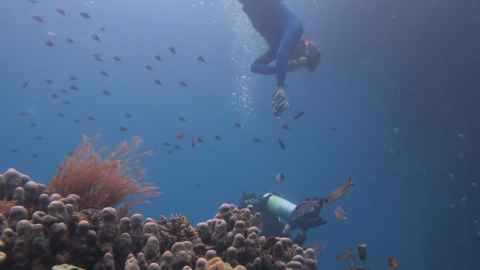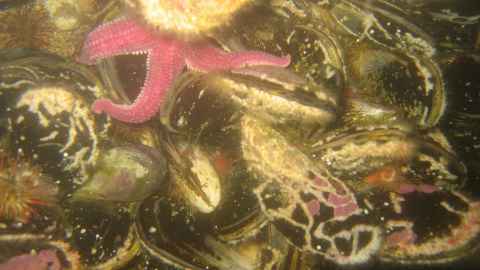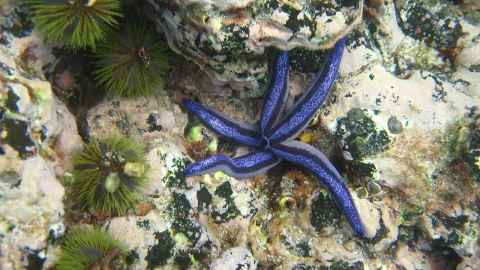It’s not too late to save ocean life
6 June 2019
Opinion: Unlike land animals, threatened marine species recover by themselves, at no cost – we just need to stop killing them, writes Professor Mark Costello.

History tells us that, as human populations expanded from Africa, there was a coincidental extinction of large animals in Europe, Americas, Asia, Australia and New Zealand. People then could not have known that their hunting was causing global-scale extinction of species. We now know better.
Business as usual will see the extinction of more large animals in the ocean. Already, Steller’s sea cow in the North Pacific, Caribbean monk seal, and great auk in the North Atlantic, have been hunted to extinction. We can do better. For example, international agreements to stop hunting the great whales led to their recovery. Unlike the case with many threatened land animals which need expensive captive breeding programmes, marine species recover by themselves, at no cost – we just need to stop killing them.
It is not just charismatic mammals and birds that are under threat. Fishery catches have declined globally for the past two decades because of over-fishing. Ninety percent of fish stocks are fished to their maximum or over-fished. Non-target species are unintentionally killed as by-catch, including birds, turtles, mammals and fish that are globally endangered with extinction. Tinkering with fishing rules cannot solve this problem because more than half the oceans are ‘high seas’ where individual countries have no authority, and even within national seas, attempts to prevent collateral damage and decline of stocks have failed.
New Zealand is no exception to these global trends.
Fisheries' politics suffer from false compromises. In too many countries, politicians negotiate fishing rules. We can no more negotiate with biodiversity than with our personal health. Yet, in Europe and elsewhere, this is what governments do. They split the difference between scientific advice to maintain or allow recovery of stocks, and what fishing companies want. This is like taking only half of the medicine or exercise our doctor recommended so that we can save ourselves money or time. It helps, but is not going to lead to the health outcomes we need, only declining health.
Market forces lead to over-fishing because companies must make profits. This can be contrary to what is best for society, recreational and artisanal fisheries, and food security for coastal communities.
Market demand drives up prices as fish become rarer, perpetuating over-fishing. This creates a gold-rush mentality where large commercial boats harvest whatever they can for profit without regard to food security of local communities and resource sustainability. Some countries are wising up to this and declaring the EEZ (Exclusive Economic Zone) off limits to such foreign fleets, or only giving permits with strict rules and independent observers on board.

Further distortion of market forces happens when countries subsidise fishing fleets, particularly those owned by large companies, with taxpayer money when they can no longer profit due to over-fishing. This perpetuates over-fishing, including by rich countries on fish stocks in developing countries. Under the UN Sustainable Development Goals and Convention on Biological Diversity Aichi Targets, many countries have agreed to stop this by 2020. The World Trade Organisation has also been reminded to step in and stop these economically and ecologically harmful subsidies which cost taxpayers USD$20 billion a year.
A proven solution to allow populations to recover is to stop fishing. It worked for the great whales, and it works in marine reserves. Internationally, almost all places (90 percent) called 'Marine Protected Areas' are not marine reserves because they allow fishing. Such MPAs really aim to apply stricter fishing rules for local food security, not protect wildlife in natural conditions. We need better management of fishing everywhere. The entire ocean should be an MPA with some places with no fishing. This is what our Pacific neighbours are doing. New Caledonia, Cook Islands, Pitcairn, and Palau, have declared all their EEZ protected.
Countries agreed in the 1982 United Nations Convention on the Law of the Sea (UNCLOS) to use ocean resources sustainably, and again in the Convention of Biological Diversity 2020 ‘Aichi Targets’ and UN Sustainable Development Goals. Yet most countries only aim to do this in MPAs which occupy less than 7 percent of the ocean. In too many MPAs, enforcement is insufficient. Many countries aim to sustainably manage fisheries in all their EEZ, but this cannot happen while they allow habitat-destroying seabed trawling, a high by-catch, and when depleted stocks have not recovered.
The best way to judge fishery sustainability would be comparisons of fished with non-fished areas. This is a challenge because three-quarters of countries do not have even one marine reserve. Those that do may not have sufficiently large, old and appropriately located reserves to allow full recovery of local fished populations. Only in marine reserves can we get close to the abundance and age structure of a natural unfished population. Better still, marine reserves allow recovery of food webs, so the abundance of all species returns towards a natural state, allowing us to see what a “natural” ecosystem looks like. Not only does this benefit fisheries, but it can prime economic growth through more profitable recreational fishing and ecotourism inside and adjacent to reserves.
In 2017, the world’s leading conservation organisation, the International Union for Conservation of Nature (IUCN), called for 30 percent of the oceans to be in marine reserves. This is likely to be the 2030 target for the Convention on Biological Diversity.

The recent 30x30 report, authored by world-leading scientists, is a well-reasoned review of the state of ocean habitats. It mapped where 30 percent of the ocean should be protected. However, their focus was on the high seas, areas beyond jurisdiction of countries that cover 61 percent of the oceans and 43 percent of the planet. They avoided selecting areas that were important for fisheries or had mining licences, thus potentially overlooking areas of high biodiversity.
Identifying priority areas for the high seas is strategic because UNCLOS is considering an international agreement to manage fisheries, and has already established the International Seabed Authority to govern mining there. However, most biodiversity, in terms of numbers of species, productivity and fisheries, occurs in coastal seas. Only 4 percent of global fisheries value comes from the High Seas so there is little too loose by banning fishing there. Two studies have shown a complete ban on high seas fishing would lead to a boost in coastal fish stocks and, by reducing travel time to offshore areas with lower fish density, increase overall fishery cost-efficiencies.
A more comprehensive recommendation, of where to locate marine reserves to protect biodiversity, would include the entire ocean. However, places with most species will not include all species. For example, polar seas contain unique but fewer species than the tropics (think of penguins, walruses, narwhals, polar bears). An ideal network of reserves would be representative of all species. In parallel, special conservation measures, inside and outside reserves, are needed for highly endangered species. Our marine biodiversity research group is designing an ideal world reserve network that considers biodiversity as a whole.
The oceans are insulted by pollution, from chemicals to plastics, and responding to climate change. But by far the greatest impact on ocean life has been and still is hunting and fishing. This is something that can be addressed through a combination of marine reserves and fisheries regulations. The solutions are proven and will result in most cost-efficient and environmentally sustainable fisheries.
It is morally and ethically honest to stop over-fishing and pollution, and common sense for our future. Marine reserves, combined with stricter rules around fishing, can result in more abundant fish stocks and more cost-efficient fisheries. Scientific evidence now supports the expected benefit of marine reserves with fish spilling-over into adjacent fished areas. Because fish are larger and older in marine reserves they contribute proportionally more to recruitment of young fish to fisheries.
There have been calls for a 'Half-Earth' strategy, whereby half of the Earth is set aside for nature, and half for humans. I am not sure how practical that is, nor whether the authors were thinking of the oceans. For the oceans I’d suggest a three thirds strategy: one third in marine reserves; one third non-industrial scale fishing promoting local food security; and one third industrial scale internationally traded fisheries.
How well is New Zealand doing? Well, we have 44 more marine reserves than most countries, we do not subsidise our fisheries and New Zealand was a leader in establishing the Antarctic Ross Sea reserve, one of the largest in the world. However, our own marine reserves only occupy 0.4 percent of our EEZ. We can do better. Our Pacific neighbours are doing over 10 times more. The Cook Islands, Kiribati, Palau, Chilean islands, New Caledonia, Fiji, Niue, Pitcairns are protecting much or all of their EEZ in MPA. Within this they have areas restricted to local fishing (food security) and reserves.
Can we catch up? It’s not happening yet, maybe because of collective akrasia (failure to act in our best interest), or because marine life is out of sight and thus mind, or is it lack of political leadership, or lobbying by those who profit from a public resource? Whatever the reason, the question remains, how can we save ocean life? We know the answers: stop killing (deliberately and accidentally); stop destroying seabed habitats; and stop polluting it. We now need communities and political leadership to implement them.
Professor Mark Costello is from the Institute of Marine Science at the University of Auckland.
This article reflects the opinion of the author and not necessarily the views of the University of Auckland.
Used with permission from Newsroom It’s not too late to save ocean life published on 6 June 2019.